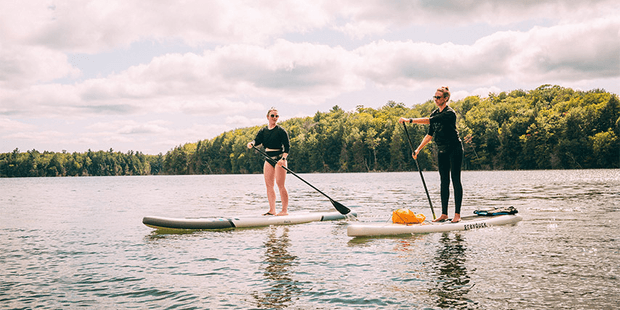How to SUP through Breaking Waves
One of the most challenging aspects of sup surfing is paddling out through the white water or recovering after you've been caught inside the break zone. So that's what we're gonna take a look at in this video. We're gonna assume that you've already developed a solid foundation of paddling skills because you shouldn't be heading out into the surf zone without them.
The first thing to mention is how important it is that you be aware of your surroundings. As a rule, when you're learning to surf and you're unsure of your ability to control your gear in the surf zone, DO NOT surf where there are other surfers, swimmers, or even waders, it's simply too dangerous for both you and those around you.
Whether you're recovering from a fall or just paddling out, you have three real options for getting through the surf:
Lie Down One option is to lie down on your board and paddle out with your paddle on the deck in front of you. This can work in smaller waves but big waves will knock you over and wash you back in. The best way to deal with big waves from a lying down position is to get off your board, push down on the tail, and push the board over the foam as you dive under the foam while holding your paddle.
Kneel The second option is to paddle out in a kneeling position and ride over the white water by leaning back and taking a hard stroke as you hit the foam. Once again, this technique will work in smaller waves but it won't be very effective when waves get over around three feet.
Standing Up The third, and best, option for getting out through the surf is to actually stand up and paddle but you need to learn how to punch over the white water first. When standing and paddling out through the surf, you'll want to assume a hybrid stance with your front foot pointed forwards and your back foot more sideways. You'll also want to have your feet slightly staggered, one towards the nose and one slightly towards the tail. You'll also want to be standing a little further back on your board to make it easier to get the nose on top of the white water when you're punching over the top of the waves.
Now what you want to do is take a few solid, but smooth, strokes on the toe side of your board to create some forward momentum toward the incoming wave. Having forward momentum is extremely important because without it you're much less stable. As the foam approaches, you're going to want to keep your center of gravity low by bending your knees. Just as the foam is approaching the nose of your board, you're going to plant a solid stroke and you're also going to want to put pressure on your back foot. Don't lean back but put pressure on your back foot, keeping your center of gravity over your board.
You're gonna take that stroke and the pressure on the back foot is gonna lift the nose over the foam. You might find it helpful to move your back foot further back as you do this. If all goes as planned, your board will skip up onto and over the foam pile. The key to making this work is keeping your knees bent and your center of gravity over your board. You're gonna wanna also maintain an active paddle. That means you're gonna have that paddle blade in the water or you're gonna have it on the surface of the water acting as a brace. If you get knocked off balance, you may have to drop to one knee but you'll need to get up as quickly as possible and get ready for the next wave.
~Shop Grey Duck SUP~
We make being on the water more fun, accessible, and enjoyable. Come with us on this journey, you won’t be disappointed.
Related Articles
How many of you have ever heard that paddle craft (vessels under oars according to the Navigation Rules)…
Even though they are flipping over, missing their gates and failing their maneuvers, they still look…
Driving a car safely involves much more than merely focusing only as far ahead as the taillights of…
The following is a modified excerpt from Ken Whiting's book, 'The Ultimate Guide to Whitewater…




